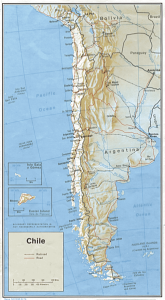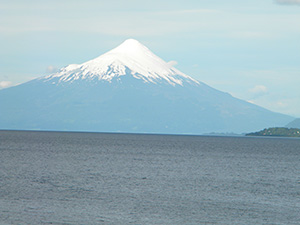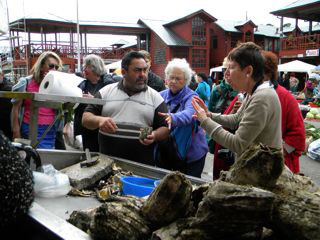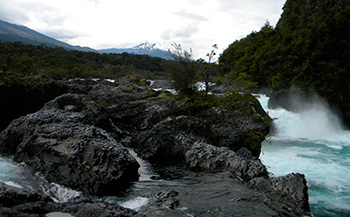Glimpses of Chile
 For decades I traveled Peace Corps style: riding buses and trains, staying at B&Bs and austere hotels, and buying most of my food in markets and small restaurants. Traveling on a low budget took extra time, planning, and effort, but it enabled me to experience life in unfamiliar countries somewhat as the natives did.
For decades I traveled Peace Corps style: riding buses and trains, staying at B&Bs and austere hotels, and buying most of my food in markets and small restaurants. Traveling on a low budget took extra time, planning, and effort, but it enabled me to experience life in unfamiliar countries somewhat as the natives did.
Gone are the days. I’ve reconciled myself to touring with a group of curious, well-traveled retirees on two-week trips planned and directed by people who make sure hotels and restaurants meet high standards and know where to find a bathroom every two hours.
In November I took such a tour of Chile and Argentina, two countries I’d avoided in my do-it-yourself days because their governments made lots of people disappear. Comfort, congenial companions, and the organizers’ good mix of places and personal encounters made the trip enjoyable and stimulating.
What we saw and heard aroused my journalistic curiosity. I can’t satisfy that, but here are some glimpses of things in Chile that intrigued me.
Protests in Santiago
Although we saw the shacks that trumpet poverty on the way from the airport, most of Santiago looked like a pleasant modern city. Jacaranda bloomed in parks. Well-dressed people (almost all white) rode a clean, quiet subway. Restaurants (seafood is huge) and ice cream places abound. We had some really good ice cream in unfamiliar flavors, and lots of young (and not so young) people were eating cones in the street.
We saw many new high-rise apartment buildings, some near blocks of old mansions that had been turned to other uses—businesses, apartments, schools. Despite a high literacy rate, quality education is more goal than reality, we heard, with the public schools bad and the private ones expensive.
The most surprising, and encouraging, thing to me was the number of protests. For years after the 1973 CIA-assisted coup that ended with leftist president Salvador Allende’s death, protestors tended to vanish. Thousands of others fled the country, with some returning after the repressed but more prosperous citizenry astonished General Augusto Pinochet by voting him out of office in 1988. (The United States gets some credit for helping Chile improve its economy.)
When we went for a walk in the central area, unionized government workers were gathering with signs to push the legislators to put a pay raise in the new budget. Stilt-walkers and drummers added a festive air. We saw small groups of protestors marching in the street several times. Police were plentiful but not obtrusive. They didn’t wear riot gear or carry military arms.
My cynical reportorial self wondered—but couldn’t investigate—who really staged these peaceful scenes.
A British tourist told me he saw a different scene from his hotel window early one morning. Police used water cannon against a group of young protestors, targeting one man in particular. A Chilean said he was probably an anarchist making trouble. A defensive excuse? Probably, but anarchists (like looters) do mix with protestors.
Put the protests in Santiago in context. International television news was showing report after report of looters and arson in Ferguson, Missouri. For months the area police had shown they didn’t know how to handle demonstrations. When I lived in D.C., people were brandishing signs whenever I passed the White House.
Lakes and Volcanoes
One reason for the trip was to see Andean scenery. The warm-up was Chile’s low-lying agricultural heartland, where grapevines, fruit trees, and corn often line the highway. The first two provide major exports. I can testify that the fruit was excellent. My companions enjoyed the wines. As to the corn, it forms a major part of the local diet, turning up in casseroles, stews, and salads.

Osorno Volcano
The most scenic area was to the cooler south around the pretty Patagonian resort town of Puerto Varas. Here our hotel looked across the huge Lake Llanquihue to the snow-topped, cone-shaped Osorno and the long, irregular Calbuco volcanoes. A few years ago an eruption spewed masses of sand-colored ash, most of which drifted east into Argentina. A ten-inch layer of ash drove nearby residents away and killed forests, crops, and the tourist trade. People have returned to the towns, and their beautiful gardens attest to the ash’s nutritional properties.
We made several interesting side trips.
• A horse-breeding ranch where huasos, a father and son, showed how they compete in rodeos quite different from ours. No roping, no bull riding, no bucking broncs. Competitors receive points for maneuvering a steer cuddled between their sidestepping Andalusian horses in prescribed patterns without harming it. Dressed in traditional garb that includes a flat-brimmed hat and a heavy, hand-woven poncho in the ranch’s colors, the horsemen eschewed lassos, and their large, round-tipped spurs didn’t harm the horses. A kinder and gentler rodeo tradition.

Market in Puerto Montt
• A Saturday market in Puerto Montt where shoppers found a variety of fresh seafood, large vegetables, and such other items as cheese. One of our most intriguing finds was a picoroco, a barnacle. The gray, tulip-shaped shell contained a white mass that shoppers took home or ate at the vendor’s stand with lemon juice. I preferred one of Chile’s favorite staples, empanadas. Turnover-sized and shaped, the empanadas held ground meat and potatoes, seafood, or cheese. In the market we saw some Native American faces.
• Petrohue Falls, a national park where green water from a lake rushes through lava formations. The low falls don’t equal the Great Falls of the Potomac near D.C., but the view of snow-capped volcanoes in the distance adds beauty.

Petrohue Falls
In Puerto Varas, we were near the last-held ground of the Mapuche. The Spanish conquistadors and their descendants (plus some other Europeans) pushed the indigenous peoples who survived attacks and diseases toward the colder, less hospitable south just as we forced native tribes west. Today the Mapuche make up approximately four percent of Chile’s population, and they’re still struggling for their rights.
A Mapuche activist and culture preservationist talked to us about the Mapuche philosophy of life, government persecution for such acts as displaying their flag, and the ongoing fight to regain the land the Pinochet government took from them and awarded to his friends. The preservationist also noted that the Mapuche, by choice, have no written language. His grandparents say the words lose their true meaning on paper.
Our program director told us that eighty-five percent of Chile’s people have mestizo (mixed) blood, and that most of them deny it.
Like most other countries, Chile has a ways to go to build a true democracy. From my limited reading and observation, class constitutes a bigger problem than race, and economic and educational inequality presents one of the country’s greatest challenges. We face the same challenge.
I filtered my observations of Chile through others’ opinions and my experiences in other countries. The friendliness of the people made me root for them. The tour didn’t give me any expert knowledge, but those few days will help me understand what I read in their history and literature and what I see on the news.
—Carolyn Mulford

Fabulous!!!! Can’t wait for Argentina!
thanks so much!
Great blog post and photos. I know a little more about Chile and Argentina now.
A friend of mine Kenneth Church and his wife were on your recent trip to Chile and Argentina. We worked together at the Board of Governors of the Federal Reserve in Washington DC. I received my bachelors in business administration from the University of Missouri in Columbia. I enjoyed your thoughts and observations of Chile and will be interested in your comments about Argentina. I have traveled to Peru and Costa Rica and have wanted to visit Chile and Argentina. I have taken several trips with Grand Circle and Overseas Adventure Travel and have alway been satisfied with what is provided during these trips.
Hope you’ve considered adding a link to this blog from the GCT website (under Traveler Stories or Travel Forum) for the benefit of potential future travelers. Also looking forward to your Glimpses of Argentina!
Thanks for the suggestion. I’ll do that. I’m not sure whether I’ll get to Glimpses of Argentina. It’s a baffling place.